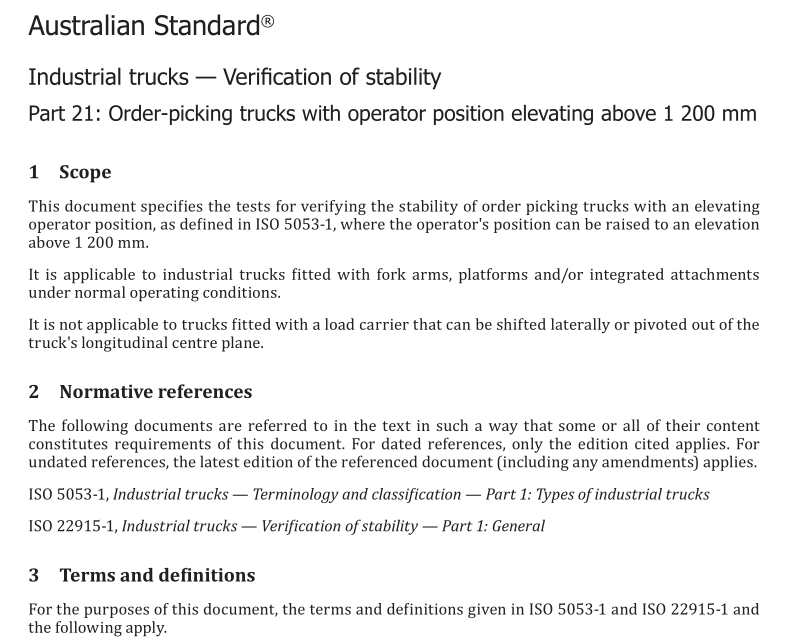AS ISO 22915.21 pdf download – Industrial trucks — Verification of stability Part 21: Order-picking trucks with operator position elevating above 1 200 mm

AS ISO 22915.21 pdf download – Industrial trucks — Verification of stability Part 21: Order-picking trucks with operator position elevating above 1 200 mm
This document specifies the tests for verifying the stability of order picking trucks with an elevatingoperator position, as defined in IS0 5053-1, where the operator’s position can be raised to an elevationabove 1 200 mm.
lt is applicable to industrial trucks fitted with fork arms,platforms and/or integrated attachmentsunder normal operating conditions.
lt is not applicable to trucks fitted with a load carrier that can be shifted laterally or pivoted out of thetruck’s longitudinal centre plane.
2Normative references
The following documents are referred to in the text in such a way that some or all of their contentconstitutes requirements of this document. For dated references, only the edition cited applies. Forundated references, the latest edition of the referenced document (including any amendments) applies.ISO 5053-1, Industrial trucks —Terminology and classification — Part 1:’Types of industrial trucks
ISO 22915-1, Industrial trucks — Verification of stability — Part 1: General
3Terms and definitions
For the purposes of this document, the terms and definitions given in IS0 5053-1 and IS0 22915-1 andthe following apply.
ISO and IEC maintain terminological databases for use in standardization at the following addresses:-lSo Online browsing platform: available at https://www.org/obp
—IEC Electropedia: available at http://www.electropedia.org/
3.1
normal operating conditions
operating conditions corresponding to the truck travelling indoors on smooth level floors of sufficientstrength such as those of concrete
Note 1 to entry:This definition is different from the one given for normal operating conditions in ISO 22915-1.3.2
guided steering
steering mode, either mechanical (e.g.guidance rails) or non-mechanical (e.g.inductive guidance, lasersensor or infrared) not controlled directly by the operator, used to steer the truck on a predeterminedstraight path while travelling
3.3
restricted steering
operation under which the truck’s steering is controlled by the operator and the steering angle islimited to not more than 10° from the forward or reverse travel direction
3.4
unrestricted steering
steering mode controlled by the operator with no limitation of the steering angle
4 Test conditions
4.1 General
See ISO 22915-1.
4.2 Position of the truck on the tilt table
4.2.1 Load and drive/steer axles
The load axle and the drive/steer axle are defined by Figure 1.
4.2.2 Tests 1 The truck shall be positioned on the tilt table so that its drive/steer axle, B–B, and load axle, C–C, are parallel to the tilt axis, X–Y, of the tilt table. See Table 1. 4.2.3 Tests 2, 3, 4 and 5 The truck shall be positioned on the tilt table with the line, M–N, parallel to the tilt axis, X–Y, of the tilt table. See Table 1. In all positions, the castor wheel(s) shall be turned away from X-Y to the orientation that produces minimum stability. Point M is the point located on the drive/steer axle end of the truck and defined as follows.
a) For trucks with a single drive (steer) wheel: point M shall be the vertical projection onto the tilt table of the point of intersection between the centreline of the drive/steer axle and the centreline of the drive wheel width.
b) For trucks with a drive/steer axle in an articulating frame articulated in the centre plane of the truck: point M shall be the vertical projection onto the tilt table of the point of intersection between the lateral axis of the articulating frame and the centre plane, A–A, of the truck.
c) For trucks with dual drive (steer) wheels: point M shall be the vertical projection onto the tilt table of the point of intersection between the centreline of the drive/steer axle and the centre plane, A–A, of the truck.
d) For trucks with a single or dual non-sprung castor wheel: point M shall be the vertical projection onto the tilt table of the point of intersection between the centreline of the castor wheel axle and the centreline of the castor wheel width.
e) For trucks with non-articulated, non-sprung castors or wheels and a non-articulated drive wheel:
1) for the non-sprung castor or wheel, point M shall be the vertical projection onto the tilt table of the point of intersection between the centreline of the castor or wheel axle and the centreline of the castor or drive wheel width, with the non-sprung castor or wheel being positioned with the centreline of the castor wheel axle nearer to the centre plane of the truck; for the non-articulated drive wheel, point M shall be the vertical projection onto the tilt table of the point of intersection between the centreline of the drive wheel axle and the centre line of the drive wheel width.









